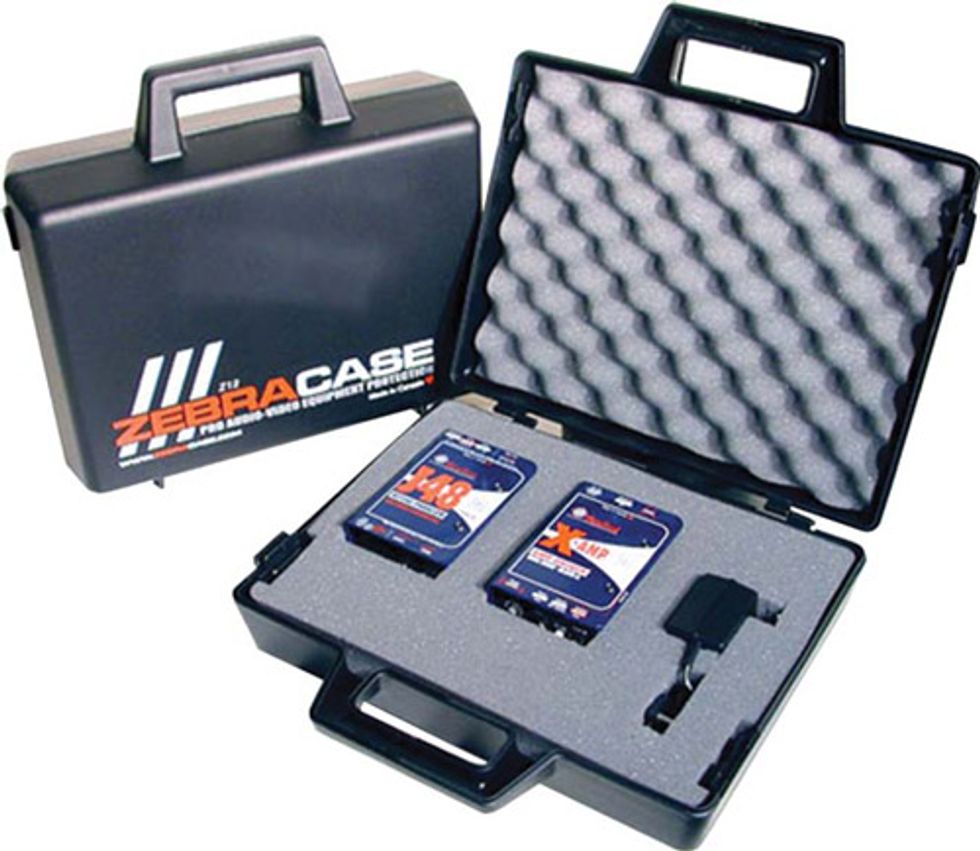
Reamping kits, like this one from Radial Engineering, include
everything you need to get started reamping your signals.
Reamping isn’t a new concept. Studio engineer John Cuniberti built and marketed the original red Reamp unit in 1994, and since then, reamping has become one of the “secret weapons” of many mix engineers and producers. But what happens if you take that concept and apply it to tracks other than guitar? Most of us have heard at least one song where the vocal track has some distortion applied to it— examples include the Breeders’ “Cannonball” and “The Big Picture” by King’s X.
There are many songs that have this distortion effect on a vocal track, and there are a few ways to get it done, but we’re going to talk about doing it by reamping the track. It’s pretty simple: Record your vocal track as you always do, whether that means some compression and EQ, or completely dry and unprocessed. Then take that vocal track and run it into your guitar amp, and voilà! A gritty, dirty, distorted vocal track. Just put a mic in front of it and record it to a new track.
You might say, “But I have plug-ins that can achieve the same thing. Why would I want to hassle with reamping?” There are two reasons for taking the reamping route: First, without getting into a debate about plug-ins versus their hardware counterparts, nothing else is going to sound like your favorite amp. The second is bragging rights. How many times have you been asked by your buddies, “How did you do that?” How cool would it be to say that you used your Marshall, Fender, Orange, or Mesa/Boogie to get that effect, and then go on to explain with authority what reamping is? Put simply, it’s a really cool way to do it, and in my opinion, a lot more fun than simply inserting a plug-in. Plus, you’re getting extra use from the gear you have, and you can apply the tones of your favorite amp wherever you like.
The Next Step
If you want to take the concept further, how about applying your guitar effects to a keyboard track? Suppose you have a vintage delay pedal that sounds absolutely killer, or a tube reverb tank that has a reverb tail to die for? With reamping, you can send a keyboard track to your guitar effects chain, and morph it into something totally new and different from the original track if you so desire.
You could use reamping to use your guitar compressor stompbox as a compressor for your drums, for instance. Reamp your drum tracks out to your guitar compressor, then bring it back in on a new track using a mic preamp and a direct box. The sound you get will depend on which compressor you’re using. It might sound great or it might not, but it’s certainly worth trying.
If you have stereo guitar effects, you can apply those to your other tracks in a similar way. Stereo delay, for instance, can really help thicken up a vocal track, and if you have a good-sounding stereo delay for guitar, you may be surprised how it can give life to a lead vocal or backing vocals. If your recording software offers a pitch-to-MIDI converter, you could even convert your vocal line to MIDI, assign it to a piano instrument, then send that out to your guitar amp, mic it, and have something really different doubling up your vocal.
If you’re not into reamping yet, you really should consider adding the technique to your bag of tricks. It’s a huge lifesaver for its originally intended purpose—to re-record guitar tracks with new tones—and if you ever have a guitar track that just doesn’t sit quite right in the mix, but is otherwise great, reamping may save the day.
Chris McCown
Chris McCown is a Sales Engineer at Sweetwater. He has been a guitarist, drummer, and bass player since 1985, and began mix engineering in 1994. He is a consultant, producer, and has worked with bands and solo acts since 2002. You may reach him directly at Chris_McCown@sweetwater.com.






![Rig Rundown: Russian Circles’ Mike Sullivan [2025]](https://www.premierguitar.com/media-library/youtube.jpg?id=62303631&width=1245&height=700&quality=70&coordinates=0%2C0%2C0%2C0)


























